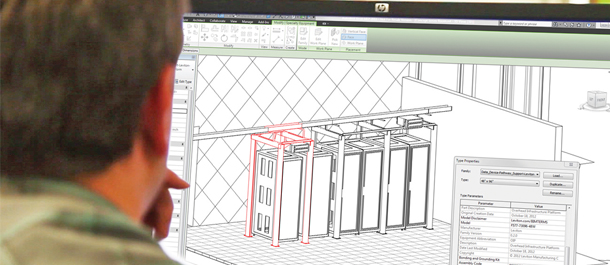Leviton Champions BIM Adoption Through NEW Standard, Enhanced Solutions

By now, if you haven't used Building Information Modeling (BIM), you've likely heard of its advantages. Projects using intelligent 3D modeling generally have fewer costly change orders, resulting in fewer conflicts and disputes. Owners have the ability to see the end product before projects are built, ensuring the design matches their vision. After projects are completed, they have a living data record for reference during the lifespan of the building.
On the cabling infrastructure side, using BIM allows users to identify specific details, such as an individual data connector in a specific port of a particular wallplate. Users can build logical relationships between components, as each connector, adapter plate, or cassette occupies a space in the three-dimensional world of BIM. Each has its own individual properties, and is associated with a wallplate, patch panel, or equipment rack with these same properties.
While BIM is not a new concept, our industry has lagged in adopting it. Companies in the electrical, aircraft, and other trades have been using BIM for many years to support larger projects, creating scheduling and project management tools associated with BIM. But over the past several years, more projects have specified BIM for network cabling infrastructure. In January 2014, BICSI published a new BIM standard, the ANSI/BICSI 003-2014, Building Information Modeling Practices for Information Technology Systems.
Chaired by Leviton Specification Engineer David Pomierski, RCDD/CSI, the BICSI committee gathered manufacturers, consultants, and end users to provide a baseline of best practices for using BIM. "We were seeing a growing number of consulting firms being asked to provide a BIM response for multi-billion dollar projects, with the only directions of 'we want it in BIM,'" said Pomierski. "You can imagine the unbelievable amount of risk that would be shared by all parties in the development stream with such minimal direction, and interpretations with such little detail. We needed some standards and guidance in place."
Pomierski, along with other manufacturers, consultants, and end users on the BIM committee, developed a standard that provides detailed information about BIM content models and object parameters. It also addresses integrating BIM into projects, and identifies information communication technology items that often enter into spatial conflicts with other areas of construction.
Leviton Takes The Lead
Leviton Network Solutions began offering BIM solutions five years ago, spearheaded by Fiber and Data Center principal Applications Engineer Dennis Manes. Since then, Network Solutions has undertaken a large initiative to develop advanced BIM content that makes it easy for contractors, consultants, and others to create and share the most accurate information for their projects.
"Much of the BIM content offered today from manufacturers delivers the most basic data and functionality, creating extra work for users trying to integrate products into their designs," said Ryan Moore, an industrial designer at Leviton Network Solutions. "Our content includes much more metadata and model properties.
"For example, say you are working with a family of patch panels in Revit® and you want to modify a Leviton patch panel model to include identification windows," said Moore. "Choosing that specific option from our family of panels will automatically change the part number and update the finished-goods schedule. Having that part number, with the ability to export it, eliminates a lot of work. Put simply, Leviton engineers have done 90 percent of the work so users don't have to."
In addition, BIM solutions from building product manufacturers are often outsourced to third parties to develop. Leviton's BIM offering is developed in-house, where the same development engineers creating Leviton products are creating BIM content. This is important, as those engineers have an in-depth knowledge of the product and a better understanding of who will be using the content.
Future of BIM
With the new standard and enhanced BIM content from Leviton, the industry has a great foundation for integrating BIM into projects. "In my mind, even though there were some early adopters of BIM, Leviton's involvement and understanding of its importance has helped kickstart a race to improve BIM offerings," said Pomierski. "And with standards in place and the top-tier manufacturers already producing BIM content, we're on the right track. We will continue to see enhancements to models and more attributes to help designers. The next step will be to find ways to reduce the size of BIM files, which will improve file sharing and productivity. And every round of updates to the BICSI standard will continually improve BIM content."
For more information about BIM, please visit http://www.leviton.com/BIM


